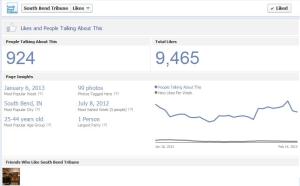While Twitter has become a platform for news organizations to posts bursts of breaking news, Facebook, founded only a few years earlier, has become a place for every celebrity, interest, and business to have a place to advertize directly to the people. News organizations are no different. What works about Facebook over Twitter, a website, or a blog?
The Platform Itself
Facebook has a place for a lot of different types of engagement. Text or links on statuses and notes; a page for background information, history, biography, mission statement; a place for photos and videos; creating events; the ability to set other subsections on the home page. The uniform layout of Facebook gives a clean, more professional look to every page than the vast creative possibilities of simply blog sites.
Direct Connection to Readers/Customers
If an individual likes or befriends your page, your post will show up on their newsfeed, which allows you to insert yourself into their social experience daily, between a friend’s status about her day at work and a sister’s baby photos. They don’t have to make a special effort to come to your page or website; as long as they don’t choose to hide your posts, it takes some effort to be able to separate your news from the social, interpersonal posts in their news feed. It’s an easy place to give them new information and self promotion.
Ease of Getting Reaction
Unlike a website or blog where you might have to sign in or create an account to comment, on Facebook, readers are already signed into that account as themselves, and below the post is that open box they just have to click on (it even says “write a comment” in the box). Even if readers had something to say on another blog or website, they may not consider it as common or appropriate to comment on it as they would on Facebook – after all Facebook encourages the social interaction. You can easily see what people’s reactions are by reading their comments.
Knowledge of Viewership
Similar to recording hits on a blog or webpage, the size of your audience can be more easily guessed by noting the number of “like” or “friends” to the page. You can also tell what articles more people might have bothered to read or enjoy by the numbers of likes to the post or number of comments on it. If you create an event, you can see how many people are, are not, are maybe attending the event.
Engagement
Lastly, but most importantly, using Facebook makes it very easy to have readers engage and participate in news, rather than passively receive it. They can read and then comment on it alongside their friends and neighbors. They which of their friends have liked the page or liked a post. They can start an argument with someone over what they believe about an issue or event. You can make readers feel like they are a part of what you are posting about and make them feel as though their knowledge and comments are important to the events you are telling the about.
For more reading on effectively using Facebook as a news source, go to http://www.journalism.co.uk/news/14-tips-on-managing-a-news-outlet-s-facebook-page/s2/a551891/.




